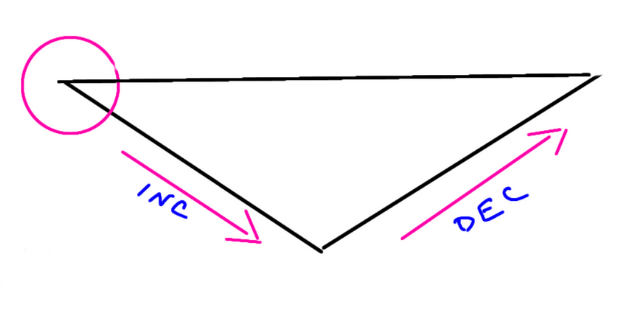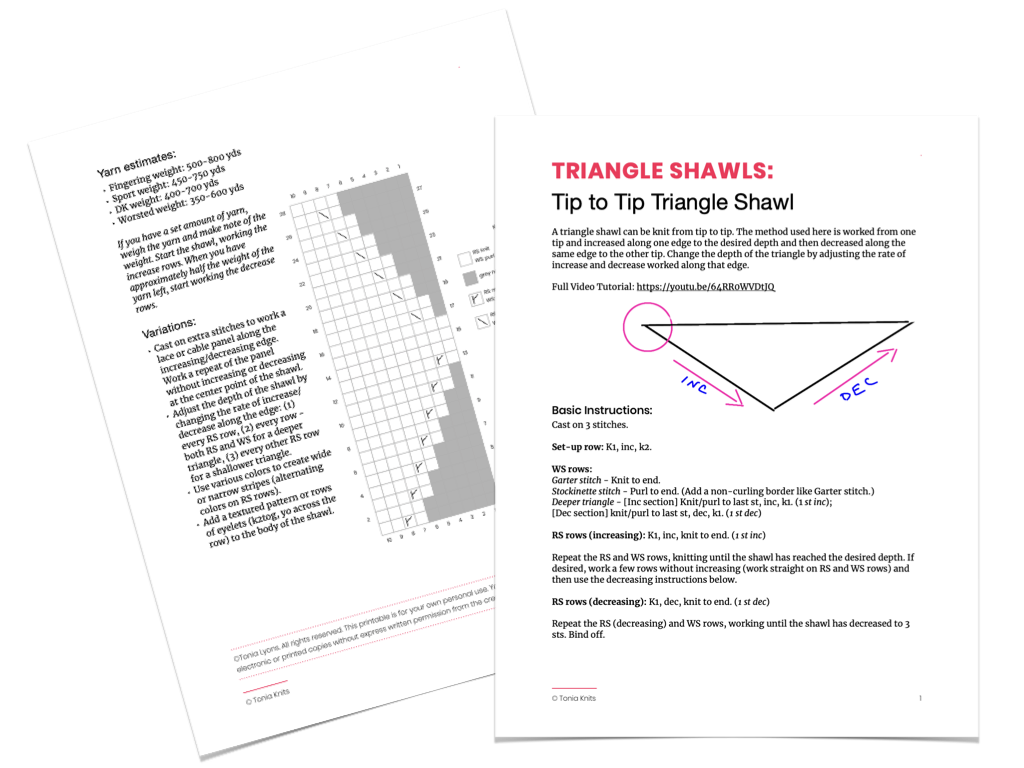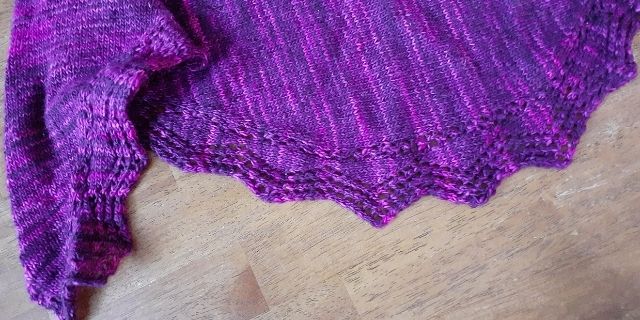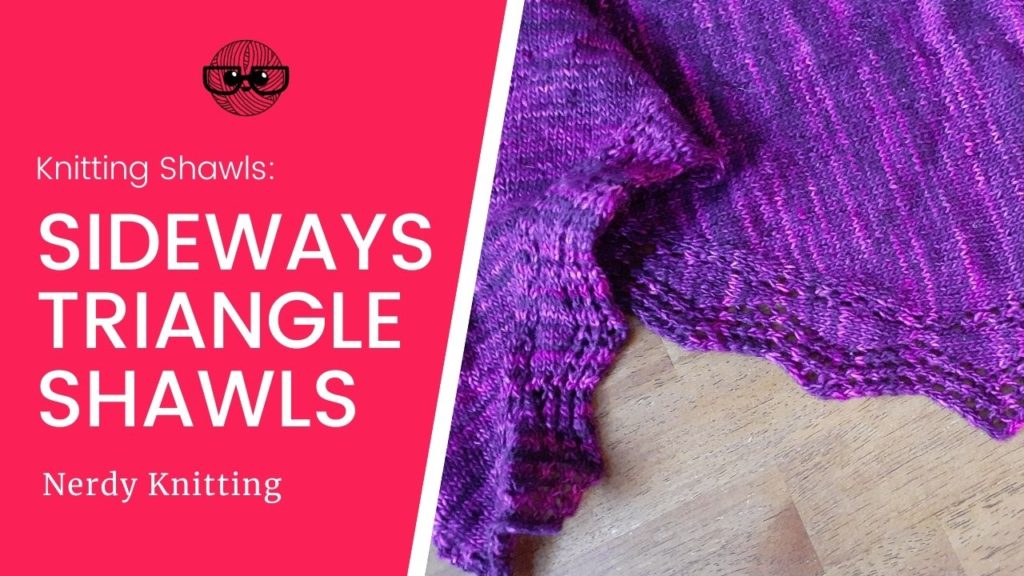Triangle shawls are popular knitting patterns. They can be knit in so many different ways and can include many different stitch patterns and colors – the options are limitless.
One method for knitting a triangle shawl is sideways from tip to tip. To knit a shawl using this method:
- Cast on a few stitches.
- Work an increase along one edge as you knit each row.
- When it’s as deep as you want you can work a few rows even or begin decreasing.
- Decrease at the same rate as you worked the increases.
- When you’re back down to a few stitches, cast off.
While those are the very basic instructions, there are so many more things to consider (and many ways to add variety to this one shape).
Construction of a Triangle Shawl Knit Sideways
A tip-to-tip sideways shawl starts by casting on a few stitches, knitting each row, and working increases along one edge. When the triangle is as deep as you want it to be, you begin decreasing along that same edge. Working increases and decreases along that one side creates the triangle shape for the tip-to-tip sideways shawl. The image below demonstrates this process:

You can easily change the depth of the shawl by adjusting the rate of increasing and decreasing along that edge.
- For a standard shawl, work an increase every right-side row.
- For a deeper triangle, work increases on every row.
- For a shallower triangle (and a long wingspan), work increases every other right-side row.
Of course, you’ll want to make a swatch to determine the final shape that you want for your sideways triangle shawl.
Knitting Instructions for a Tip-to-Tip Shawl
Here are the basic instructions for a Garter stitch sideways triangle shawl:
- Cast on 3 stitches.
- Set-up row: Knit 1, increase, knit 2.
- Row 1 (WS): Knit.
- Row 2 (RS): Knit 1, increase, knit to end. (1 stitch increased)
Repeat Rows 1-2, using the increase of your choice, knitting until the shawl has reached the desired depth. Of course you can change the depth by changing the rate of increase (increase every row for a deep triangle or every other right side row for a shallow triangle).
If desired, work a few rows without increasing (work straight on RS and WS rows) and then use the decreasing instructions below.
- Row 1 (WS): Knit.
- Row 2 (RS): Knit 1, decrease, knit to end. (1 stitch decreased)
Repeat the decreasing rows, working until the shawl has decreased to 3 stitches. Bind off.
It’s really as simple as that – but there’s so much more you can do with this shape once you understand its basic construction.
Get the Pattern

Fill in the form below to get access to the FREE Resource Library – and get a copy of the Tip-to-Tip Triangle Shawl pattern ‘recipe’.
Modify the Pattern
The instructions above will produce a Garter stitch tip-to-tip shawl since you are knitting every row. If you prefer a Stockinette shawl, you would purl on the wrong-side rows.
One thing to note – Stockinette tends to curl so be sure to add a small border to both edges to keep the Stockinette from rolling. If you want to do this, replace the wrong-side rows with this instruction and you’ll have a shawl with a Stockinette body and a simple 3-stitch Garter edge:
- Row 1 (WS): Knit 3, purl to final 3 stitches, knit 3.
Because of this easy shape, it’s simple to add another stitch pattern so don’t think you have to stick with Garter stitch or Stockinette. Establish your stitch pattern and then, as you increase along the edge, work those new stitches into the stitch pattern. And, when you start decreasing, maintain the pattern as much as possible. This is another good time to try a swatch to make sure it will work out the way you want.
Adding Color & Texture
Besides the background stitch, the easiest adjustments to make are color and simple texture.
There are so many ways to add interest with color:
- Choose a gradient yarn that will do all the color changing for you.
- Work small or wide stripes in Garter stitch.
- Fade from one color to another, alternating between colors at intervals to ‘fade’ from one color to another.
- Add a few small sections of a simple slip-stitch or Mosaic pattern.
You can also add texture easily by working eyelets along one edge or at set rows along the body of the shawl. Or alternate sections of Garter stitch with sections of Stockinette. This doesn’t really require any extra preparation. But if you want something a little more involved, try adding a stitch pattern (see the next section for more information).
Charting a Stitch Pattern
If you want to use a more involved pattern like cables or lace, then charting out the design to see how it will look is a good idea. The image below shows how a basic Stockinette background would look – and how you could use that space to add a stitch pattern. There are a few ways to add a pattern stitch:
- Work in your preferred background stitch (like Garter or Stockinette) until you have enough space to incorporate a full repeat of the stitch pattern you’ve chosen.
- Figure out how to add partial repeats of the stitch pattern to fill in more of the background space.
A chart is really a great way to work out any stitch pattern, because it gives you a visual of how the finished shawl will look and it gives you some space to experiment and try out a stitch you might not have considered. You can get a free copy of the chart below for your own experimentation – just fill out the form above.

Adding a Border or Edging
Another great option with this type of shawl construction is adding borders or edgings.
If you’re working a Stockinette shawl, you’ll want a border at each edge to keep it from curling. While the basic instructions above show you how to add a simple Garter stitch border, there are plenty of other choices. Try a simple eyelet edging or I-Cord or even a small cable along the top edge of the shawl (the neckline).
I love using this shawl construction and adding a patterned border along the increase/decrease edge. To do this, choose your edging pattern (something that can be worked parallel to the body of the shawl). Cast on three stitches for the body of the shawl (as instructed above) and also cast on enough stitches to work the border. You will work the edge stitches, increase, then work the body of the shawl.
This is a good way to work the shawl body in a basic stitch and then add some extra interest with a border. It’s much easier to add a border than try to integrate a stitch pattern into the body of the shawl. So if you are new to this construction method, this is a great starting point if you want to design your own shawl.

Yarn for Shawl Knitting
Now that you know all the basic information you’ll need to knit your own tip-to-tip sideways triangle shawl, you’ll need to get some yarn and start knitting. The table below will give you a rough estimate for the amount of yarn you’ll need. The smaller number will create a small shawlette and the larger number will create a larger shawl.
| Yarn Weight | Yardage Estimate |
|---|---|
| Fingering | 500-800 yards |
| Sport | 450-750 yards |
| DK | 400-700 yards |
| Worsted | 350-600 yards |
But if you have a set amount of yarn that you want to use, this shawl is the perfect choice with a few simple calculations:
- Weigh the yarn on a kitchen scale and make a note of the weight.
- Start the shawl, working the increase section until you’ve used half (or slightly less than half) of the yarn, weighing the remaining yarn as you knit.
- Begin working the decrease section with that remaining half.
As far as the fiber content of the yarn, the sky is the limit. Choose wool or alpaca and knit a warm and cozy shawl. Try a silk and wool blend for something that will drape beautifully. Or give a plant fiber like pima cotton or bamboo a try for a lightweight summer shawlette.
Now you’re ready to knit your own sideways triangle shawl!
If you want to see this basic construction method in action, watch this video:
Links below are affiliate links. If you click through and make a purchase I may make a small commission at no extra cost to you. See the Disclosure for more information.
Recommended Resources for Shawl Knitting
- Custom Shawls for the Curious & Creative Knitter by Kate Atherley and Kim McBrien Evans (available on Amazon)
- Knit Shawls & Wraps in One Week by Marie Greene (available on Amazon)
- The Magic of Shetland Lace Knitting by Elizabeth Lovick (available on Amazon)
- Knitting Modular Shawls, Wraps & Stoles by Melissa Leapman (available on Amazon)
More Articles about Knitting Triangle Shawls
- 10 Knitting Patterns for Sideways Triangle Shawls (knit tip to tip)
- 12 Beginner Shawl Knitting Patterns
- How to Knit a Bottom up Triangle Shawl
- How to Knit an Asymmetrical Triangle Shawl (Two Ways!)
